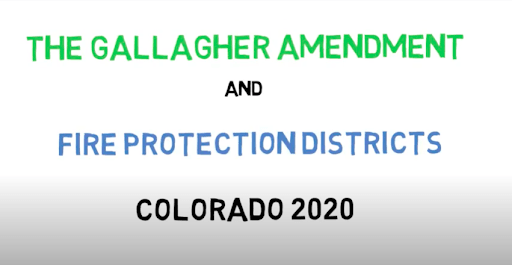The Gallagher Amendment: Information for Ballot Question 7B
By admin Published October 1, 2020

A Word from the Chief
So far in 2020 our fire district and community have dealt with the COVID-19 pandemic and the long-lasting effects of a very active, dangerous, and serious wildfire season.
During the past seven months, we were required to not only learn about a pandemic but, also to rapidly purchase, equip and train our responders to a new disease process and a threat to the people of our communities. Like many people, our crew members had to do this while learning how to best protect their families from the threat of COVID-19. As a chief, I have been witness to the incredible efforts and care that our responders have given to every patient that they have encountered. Again, all while giving great care and attention to protecting each other and their own families. We are blessed to have these exceptional people in our midst.
Additionally, so far this year, we responded to 910 calls for service including 400 medical emergencies, 52 motor vehicle accidents, along with 25 wildland fire incidents. CRFPD also answered the call both locally on fires including the Grizzly Creek and Red Canyon fires along with 4 national wildland fire deployments in both Colorado and California.
CRFPD’s hardworking crews train, prepare and respond throughout the year in order to offer a consistently high standard of care to any and all emergencies.
I am grateful for their dedication to excellence that has once again been shown this year. We have a truly great group of folks protecting us in the Carbondale & Rural Fire Protection District.
– Rob Goodwin
What is the Gallagher Amendment?
The Gallagher Amendment was added to the Colorado constitution in 1982 and sought to curb snowballing residential taxes and provide relief to homeowners. It mandated that state property tax revenue would be comprised of 45% residential property taxes and 55% commercial taxes. Property tax assessment rates under Gallagher were initially set in the state constitution to be 29% for non-residential property and 21% for residential property. The residential assessment rate was adjusted every two years to maintain the 45%-55% split between the total share of property tax revenue. The current residential property tax assessment rate is 7.15% and is expected to decrease to 5.1% in 2021 if the current law remains standing.
For a more comprehensive breakdown, watch this video of the Gallagher Amendment and how it pertains to Fire Protection Districts.
Why Is This Important?
In Colorado, property taxes are collected by school districts, county governments, fire protection districts, and other special districts. Not only does the Gallagher Amendment put fire protection districts at risk for loss of funding, but it also puts financial distress on small businesses who are already reeling from the effects of the pandemic. To put it in perspective: If the residential rate is cut to 5.1% in 2021 (as projected) businesses would be on the hook for five times the residential tax rate.
The formula used in the Gallagher Amendment triggers tax cuts based on a statewide calculation, without consideration to what’s actually happening to individual taxpayers or specific government agencies. In metropolitan areas, this balancing act does not affect special districts or businesses as much as it does in rural areas. Small public agencies (like fire departments, hospital districts, and county governments) in rural areas that rely on property taxes have been hit hard financially. Complicating matters further, some taxing districts have small amounts of commercial property, making a residential tax cut that much harder to cope with financially. In fact, CRFPD is 88% residential property.
Many communities have responded to Gallagher-initiated cuts by raising mill levies, the part of the property tax equation that people are more familiar with. CRFPD voters approved a mill levy increase and bond in 2018, which allowed the fire department to buy new trucks, ambulances, a brush truck, remodel stations and start work on the upcoming training ground project. Essentially, this year’s election will ask taxpayers to approve the stabilization of those funds for the department for years to come and not be dependent on the Gallagher Amendment calculations.

What This Means for the Carbondale Fire District
This year’s ballot question would maintain the level of funding that was approved by the voters in 2018. This funding is imperative to the department to maintain needed emergency response staffing levels, continue and improve the delivery of high-quality training to all members, and continue to rapidly respond to medical emergencies, wildfires, rescue calls, and building fires 24/7.
This funding stabilization (de-Gallagherization) will allow the Fire Department to:
- Continue its successful seasonal staffing and wildland fire response programs
- Continue to serve a 300-square mile area with 15,000 permanent residents
- Continue a turn-out time of 4 minutes for ambulance calls
- Respond with paramedic level service on concurrent calls
- Continue implementing changes from the master plan
The Gallagher Amendment acts as a “one-size fits all” approach, but unfortunately, that is not how the communities in our state work. At the time that this amendment was put into law, the property scale was reasonably balanced, but as time has gone on and demographics have changed in our state, this amendment has not changed with it. The election question for 2020 asks for stabilization of the tax rate so that Carbondale Fire can continue to serve, and protect our community. If you have any questions or would like more information, please feel free to reach out to your friends at the Carbondale Fire Department.
